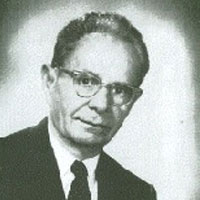Moshe Nathanson (1899-1981), son of Rabbi Nahum Nathanson, was born in Jerusalem in 1899. Until age 10, Nathanson attended a traditional heder (all-boys religious school) in the old city of Jerusalem. Moshe left the heder to attend Bet Sefer Lemel, the elementary division of the Ezra school in Jerusalem, where Abraham Z. Idelsohn was the director of the choir. Sheldon Feinberg, in his book “A Song Without Words” claims that Idelsohn assigned his students to compose words to the niggun on which Hava Nagila is based. Feinberg asserts that Moshe Nathanson was in fact responsible for the lyrics that have become so popular today.
In 1922, Nathanson immigrated to Canada, where he studied Law and Music at McGill University. Mid-degree, Nathanson decided to transfer to the Institute of Musical Art in New York (now the Julliard School of Music). In 1924, he became the cantor at the Society for the Advancement of Judaism (Morecai M. Kaplan’s Synagogue in New York, and the founding community of the Reconstructionist movement in the United States), a post he held for over forty-six years. One of Nathanson’s most important contributions to the field of Jewish music is his compilation of liturgical melodies Zamru Lo (4 vols.), which is still widely used in the USA today.
Aside from his work at the SAJ, Nathanson was involved in a number of projects to promote Jewish and Palestinian folk music. For example, Nathanson was the one of the main contributors to the “Voice of Jerusalem,” a weekly WMCA radio program to promote Hebrew culture and song. The first broadcast was released a month before Passover 1931, with support from sponsor Horowitz-Margarten Matzoh company. Many of songs aired on program were performed by a choir directed by Meyer Machtenberg. “Voice of Jerusalem” aired for ten years in all. Nathanson also became involved in a special project sponsored by the Bureau of Jewish Education to teach Jewish Day School and After school teachers Shire Eretz Israel (Israeli folk songs), so that they could impart the tradition to their students. Nathanson’s collaboration with Dr. Judah Lipson, lead to his involvement with the Bureau’s summer camp, Achvah, where he served as the Musical director for many years.
Nathanson passed away in February of 1981, survived by his three children, Deena Starr, Naomi Brettler, and Yaron Nathanson.
22 Songs Composed by Moshe Nathanson
-
Hava Nagila2:26
-
Hava Nagila
-
Hava Nagila4:39
-
Hava Nagila2:13
-
Hava Nagila4:51
-
Hava Nagila2:35
-
Hava Nagila1:47
-
Hava Nagila2:25
-
Hava Nagila1:41
-
Hava Nagila2:30
-
Hava Nagila3:04
-
Hava Nagila2:12
-
Hava Nagila3:24
-
Hava Nagila2:29
-
Hava Nagila2:26
-
Hava Nagila2:50
-
Hava Nagila2:56
-
Hava Nagila3:15
-
Hava Nagila2:16
-
Hava Nagila5:05
-
Hava Nagila1:58
-
Hava Nagila - Artza Aleinu - Eveinu Sholem Aleikhem2:14


10 thoughts on “Kaminos”
Was Nicholas related to Alexander Saslavsky who married Celeste Izolee Todd?
Anyone have a contact email for Yair Klinger or link to score for Ha-Bayta?
wish to have homeland concert video played on the big screen throughout North America.
can organize here in Santa Barbara California.
contacts for this needed and any ideas or suggestions welcomed.
Nat farber is my great grandpa 😊
Are there any movies or photos of max kletter? His wife’s sister was my stepmother, so I’m interested in seeing them and sharing them with his wife’s daughter.
The article says Sheb recorded his last song just 4 days before he died, but does not tell us the name of it. I be curious what it was. I’d like to hear it.
Would anyone happen to know where I can find a copy of the sheet music for a Gil Aldema Choral (SATB) arrangement for Naomi Shemer’s “Sheleg Al Iri”. (Snow on my Village)?
Joseph Smith
Kol Ram Community Choir, NYC
שלום שמעון!
לא שכחתי אותך. עזבתי את ישראל בפברואר 1998 כדי להביא את בני האוטיסט לקבל את העזרה המקצועית שלא הייתה קיימת אז בישראל. זה סיפור מאוד עצוב וטרגי, אבל אני הייתי היחיד עם ביצים שהביא אותו והייתי הורה יחיד בשבילו במשך חמישה חודשים. הוא היה אז בן 9. כעת הוא בן 36 ומתפקד באופן עצמאי. נתתי לו הזדמנות לעתיד נורמלי. בטח, אבות כולם חרא, אומרים הפמינציות, אבל כולם צריכים לעבוד כמטרות במטווחי רובה!
משה קונג
(Maurice King)
Thank you for this wonderful remembrance of Herman Zalis. My late father, Henry Wahrman, was one of his students. Note the correct spelling of his name for future reference. Thank you again for sharing this.
Tirza Wahrman (Mitlak)
amazing zchuso yagein aleinu, he wrote the famous niggun Lefichuch that is sung in almost every Israeli Yeshiva